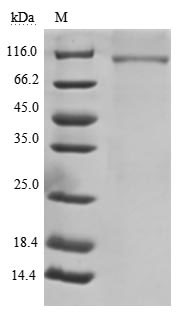The human B-cell receptor CD22 mediates the interactions of the B-cell and the B-cell antigen receptor signaling. It responds to sialylated glycoproteins and can be affected by free sialic acid. Its function is the regulation of cell adhesion, immunoglobulin secretion, and B-cell proliferation. The recombinant protein is the 20-687aa region of the CD22, expressed in mammalian cells. The protein was fused with a 6xHis-tag on the C-terminus, with a molecular weight of 77.9 kDa. SDS-PAGE analysis shows that the product has a purity greater than 90%. As well, it was determined by ELISA that the EC50 was 4.034-4.800 ng/ml for binding to the Anti-CD22 rabbit monoclonal antibody. The final product has low levels of endotoxin, with less than 1.0 EU/µg as determined by the LAL method. The protein can be used on binding and modulation essays; this with the scope to determinate novel antigens presented by IgM, B-cell differentiation, and modulation and immunoglobulin production studies. It can be used as well in cancer research on tumoral antigen response and modulation.









